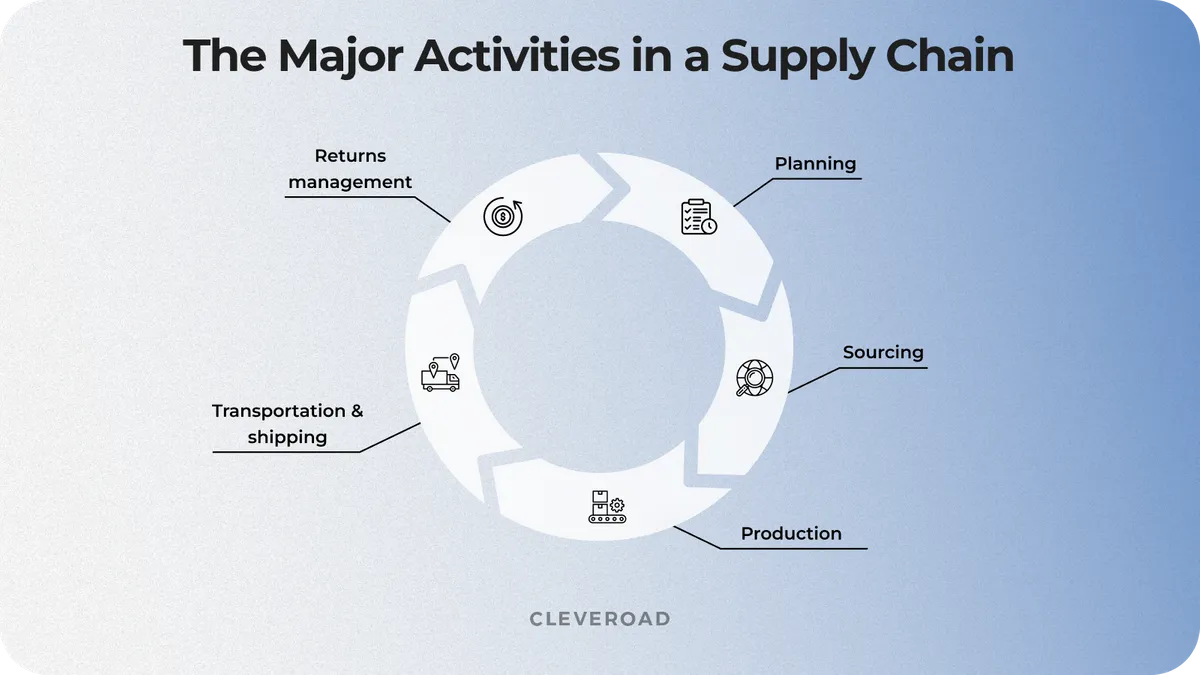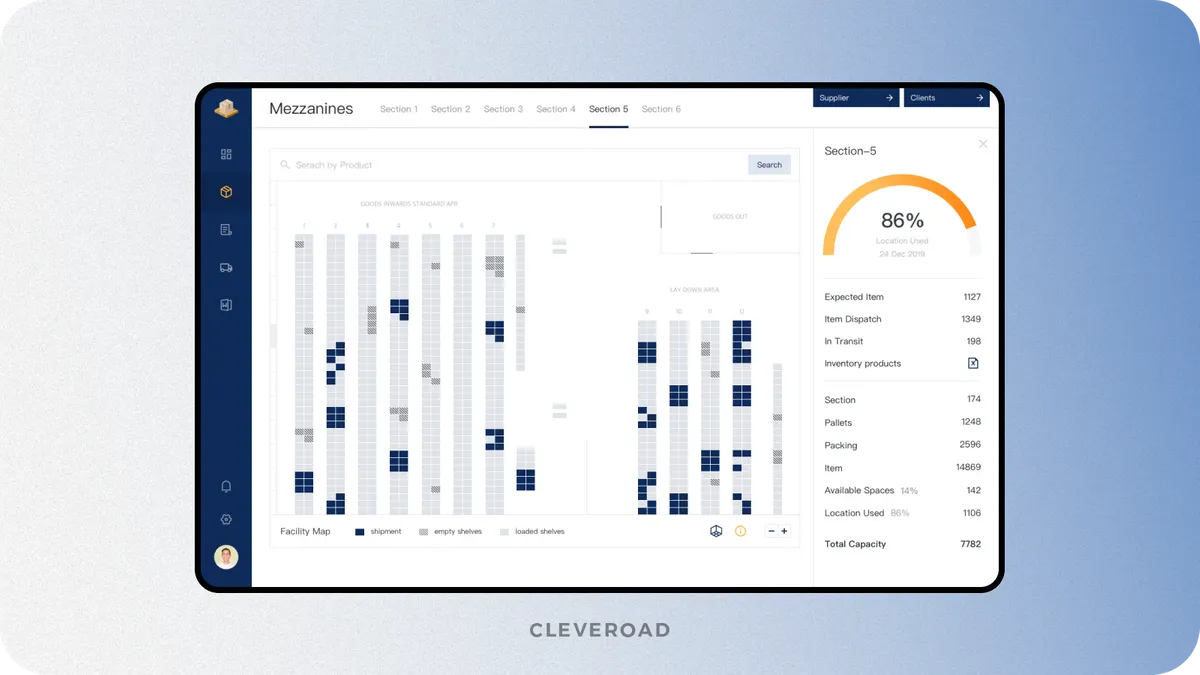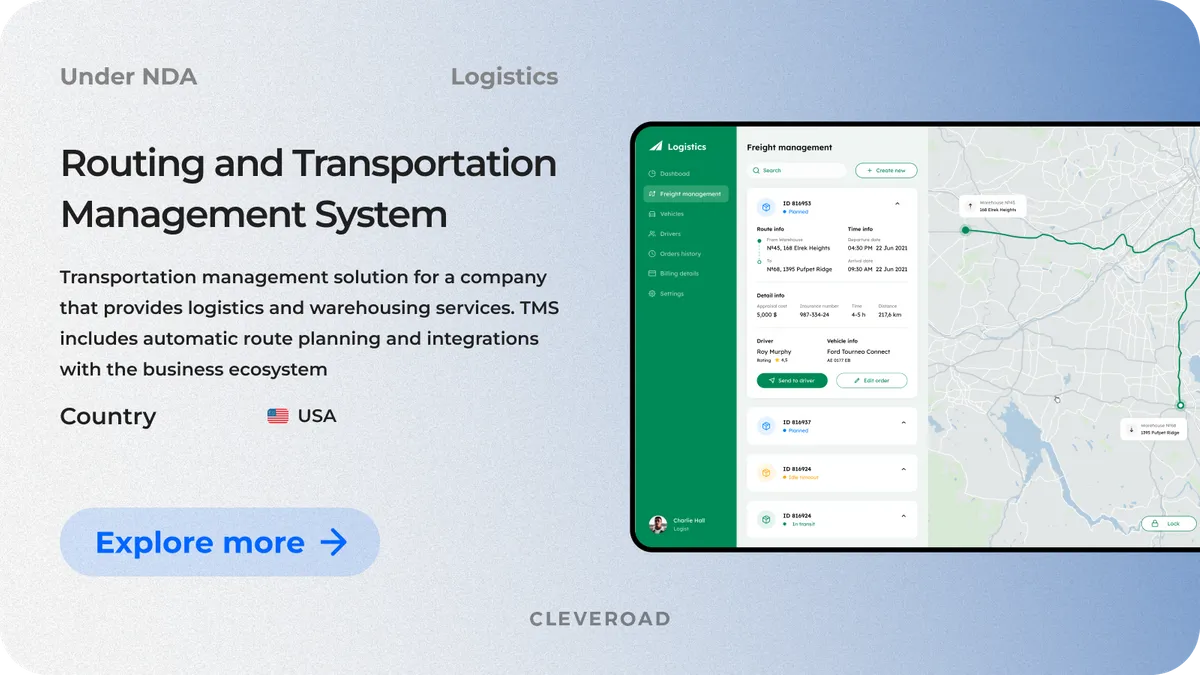What Is a Supply Chain Management System: Essentials, Benefits, and More
Updated 30 Apr 2025
15 Min
1667 Views
What does supply chain management software do for your logistics company? By automating and simplifying specific logistics operations, it enables you to better manage and track performance in real time and obtain optimal efficiency across the supply chain.
We�’ve prepared this article to gather our logistics software development experience for you. Let’s dive into what a supply chain management system is, how it functions, what value it provides, and what key trends are driving its evolution. It will arm you with the knowledge and insights to build and run a modern SCM solution.
What Is Supply Chain Management?
Supply chain management (SCM) is the business process of managing data, items, and funds concerning the particular goods or services, from receiving raw materials to the product’s delivery. The operations are performed through a row of suppliers that serve as particular chain links conveying the resources for a new product to manufacturers and then to direct interaction with end-users.
Why is a supply chain management system important? Every item launched on the market results from cooperating with different supply chain participants performing manufacturing, load dispatching, and allocation activities. That’s why Dave Waters mentions:
Dave Waters
Senior Supply Chain Manager in STERIS Corporation, UK
Supply chain is like nature; it is all around us.
Why you should invest in software in supply chain management for your business
SCM process assists managers and business owners in running different supply chain activities performed on the chain’s sections. Such a management gains popularity among the clients and business owners. So, Allied Market Research proves that SCM has been invested a lot: a supply chain market share reached $27.2 billion in 2023. It’s projected to increase to $85.3 billion by 2033.
So, what is the supply chain management software? It is a digitized tool that manages, controls, and regulates the transport of goods, information and money throughout the entire supply chain. It also enables organizations to streamline operations, monitor inventory on the go, and drive smart decisions that lead to improved performance overall.
Let’s discuss other benefits of SCM system development:
Streamlined workflow. Resilient SCM systems will let you streamline operations, minimize manual work, and remove bottlenecks. For instance, digital supply chain solutions can predict stockouts in advance, enabling your team to modify purchase process and prevent large periods of downtime.
Improved cooperation. With custom SCM software, it’s easier to communicate the work between departments because development and operations work in the same workflows. Data pulled out of the production process and shared with the shipping team in real-time results in smoother hand-offs, less confusion, and quicker response and reaction time.
Better customer experience. Service accuracy and transparency have been enhanced by modern SCM systems. A digital foundation also means you can offer accurate delivery windows, order tracking, and service levels, intended to satisfying customers in this digital age.
Smarter long-term growth. Investing in supply chain software development prepares your company for scalability and sustainability. Customised digital solutions work for a logistics operation that is increasingly dynamic and competitive, and adapt to shifts in market demands.
How the supply chain system works
To have faster delivery to the client, the supply chain should be well-managed and controlled. In order to accomplish this, it is first important to understand the basics of supply chain management, its core elements, and how software solutions can best help improve operations.
The following five stages are a typical path that products move through in the supply chain:
- Planning. At this stage, logistics experts monitor KPIs to measure how effective and reliable the supply chain processes are. They also estimate the amount of materials the company needs to meet its goals and maintain strong visibility across all operations.
- Sourcing. Supply chain management specialists find and work with vendors who can supply the necessary resources for production, improving supply chain visibility.
- Production. This phase covers all manufacturing activities, including receiving materials, producing goods, conducting quality control, packaging, and organizing shipments.
- Transportation and shipping. It handles customer-facing tasks like order management, invoicing, payments, and dispatching deliveries. An efficient custom warehouse management software can streamline these operations and speed up dispatches.
- Returns management. This process manages product returns for items that are damaged, defective, or unwanted, while maintaining strong supply chain visibility to track and analyze return patterns.

Major activities in supply chain
Types of Supply Chain Management Systems
Knowing the various types of solutions for supply chain software development can help you choose the right technology to optimize supply chain operations. Enterprises often choose to invest in SCM development based on specific business operations requirements.
Common SCM software products include:
Product lifecycle management solution
The supply chain management system needs to effectively manage goods from the very beginning. Smart product lifecycle management software contributes to sustainability. Moreover, by integrating machine learning into tracking and decision-making, you will be able to identify inefficiencies and adjust strategies at an earlier stage. Managing every stage of the lifecycle creates a more competitive supply chain stronghold.
Inventory management software
A good inventory management software provides profitability for your company by offering the necessary products available at any time. Experienced supply chain and operations experts track inventory levels intently to avoid waste and shortages. A strong supply chain system allows businesses to have a demand forecast and a reliable replenishment plan. The accuracy of stock management subsequently promotes efficient warehouse flows and greater customer service.
How to benefit from inventory management software development? Discover our article to learn more!
Supply chain risk management application
A proactive approach to risk management has become critical to keeping supply chains resilient in volatile markets. So, you can leverage specialized SCM system risk management solutions to track threats to offsite inventory and supplier weakness. Resilience is the answer to maintaining and protecting revenue streams and the trust of customers.
You can contact us to build the custom system for supply chain management for a particular SCM operation and increase productivity. For instance, with the addition of inventory management software, your warehouse teams can better predict demand and manage replenishment proactively.
The Key Features of The SCM Software
The required functionality for an SCM solution should be considered in terms of the supply chain components. The logistical experts say there are 14 supply chain parts; however, we'll look at the most vital parts of the supply chain management in simple words and features that should be implemented.
Procurement and supplier management
Effective SCM management starts with powerful procurement and supplier management solutions. The optimal solutions offer you comprehensive insights into supplier relationships, contract compliance, and purchasing efficiency. For instance, software development teams can connect real-time supplier dashboards to monitor the performance of vendors and catch supply chain disruptions before they cause delays.

Admin panel for logistics system designed by Cleveroad (Source: Dribbble)
Demand forecasting and planning
Accurate demand forecasting and planning are necessary to make smart decisions and empower a stronger end-to-end supply chain. Predictive analytics help your logistics experts forecast market trends, schedule production, and minimize waste. Moreover, if you integrate forecasting tools with ERP systems, your SCM software will respond faster and allocate resources more effectively.
Inventory and stock control
Modern inventory management systems track inventory levels, warehouse inventory, and automate requisition processes, preventing stockouts and overstocking. Using digital supply chain management solutions, you can manage inventory flow to perfection, ensuring product availability when customers are ready to buy.

Inventory management app by Cleveroad (Source: Dribbble)
Logistics and transportation coordination
Efficient supplies chain management relies on smooth transportation management and delivery coordination. Powerful systems monitor shipments in real time, optimize routes, and reduce transit costs. Practical logistics management delivers better service levels and strengthens customer trust.
Smart features
Modern supply chain software solutions need to include smart features beyond basic tracking and reporting. Tools like AI-driven route optimization, automated project management workflows, and embedded software supply chain security protect operations and data integrity. Investing in smart features positions your company to thrive in an increasingly competitive market.
How to Develop a Supply Chain Management System That Fits You?
Building an SCM platform that precisely fits your business needs is a key to the success of your company activity. So let’s learn how to do that.
Map the supply chain workflow
Before building software for supply chain management, begin by mapping out your entire workflow, from sourcing and production to delivery and returns. And this map shows how goods, data, and decisions move throughout your global supply chain. It's important to understand each of these processes to determine the appropriate software components to use and identify gaps that digital solutions can fill.
Regardless of whether you're a product development shop or a company focused on fulfillment, this precision ensures you assemble a custom supply chain management (SCM) system bespoke for your needs. A well-charted workflow can even help your supply chains become more resilient, identifying vulnerabilities before they translate into expensive interruptions.
Gather business requirements
Starting your SCM system creation and having found out what’s supply chain management, you need to make some preparations. Define the aims you want to gain by the project development, find the stakeholders and contact them.
Among different questions about supply chain management to ask and solve, you can offer them the following ones:
- What is the end purpose of the upcoming system?
- What features do you require to include in your wishlist for your supply chain management solution’s proper upgrade and further attractiveness?
- What mainly are you interested in concerning the future system?
According to your stakeholders’ propositions, prepare project requirements and put them into a document to respond to what is a supply chain management (SCM) particular purpose.
Choose a skilled outsourcing IT provider to collaborate with
In order to create a flexible supply chain and enhance overall workflow performance, you need an experienced software development company which has strong expertise in logistics, particularly in multi-modular and complex SCM systems development. Give priority to service providers that have a strong experience in custom software development services, such as IT consulting, SCM systems creation from the ground up, and legacy software modernization.
Also ensure they have capabilities around advanced technologies (e.g., AI&ML, IoT, cloud, etc.). They must have experience working in various supply chains and show how to build an SCM management system that suits your situation.
In order to develop such a complex solution as a SCM software, we recommend you to outsource this task to an experienced IT vendor. When you outsource your IT project, your company receives the benefit of worldwide experience, without the overhead costs of supporting an in-house development team lowering operational costs and speeding delivery to market by utilizing industry best practices.
To get the perfect partner, you can visit the vendor’s portfolio and evaluate their experience in the field of supply chain software development. Also, don’t forget to look through client reviews on reputable platforms, such as Clutch, to measure credibility and performance. A strong vendor will show that they can provide custom logistics flow solutions, retain a sturdy and skilled group of logistics software development experts, and give long-term support to help you create a more reliable and adaptable supply chain.
At Cleveroad, we are dedicated to Logistics and Supply Chain software development that truly works, creating solutions equipped with innovations based on the clients' needs. A digital accessibility leader Verbit is one of our clients that caters more than 3,000 companies and organizations. Our team helped Verbit streamline their internal logistics processes with tailor-made software solutions.
That’s what Krisztian Klausz, Head of R&D at Verbit, says about their teamwork with our logistics software development specialists:
Krisztian K., Head of R&D at Verbit gives feedback about cooperation with Cleveroad
Choose the development approach
There, you should decide how to create your future SCM system – whether you are planning to develop it from scratch or to configure an open-source product.
Personalizing an open-source solution can dramatically decrease the cost of development and accelerate time to market. But these systems don’t always integrate and doesn’t always fit your workflows. So you have to spend time to set them up in addition to making limitations in terms of flexibility and scalability.
Custom software development, on the other hand, is costlier from the outset, but allows to create a perfect solution tailored to your business logic, processes and future growth. This is the approach that offers the most flexibility and is an opportunity for you to gain a competitive advantage in the logistics sector you operate in.
Discuss your SCM system needs
After you’ve determined the development strategy, it’s time to define the major requirements for your future warehouse management system. At this stage you will work closely with your development team to find out which features you want to implement, what architecture you want to run, and what your systems should do to fit into the exact business processes.
You'll work with your team together determining where across your current tools and platforms the integration points lie. These systems can be ERP (such as SAP, Oracle), WMS, TMS, CRM and procurement solutions. Planning for integration from an early stage enables smooth data flow through your business and improved system performance.
Start a SCM software development
Now, the development team starts working. They define tailored functionality according to your needs and supply chain model. Moreover, the development team creates the product backlog. It includes all the features, which are then negotiated and broken down into the user stories with acceptance criteria to be implemented by the developers.
To speed up development and keep costs down, the team can include third-party services (cloud analytics services, routing plan tools, supply chain APIs, ERPs and WMSes). This method helps to save time of no need to reinvent the wheel and faster time-to-market.
The system is built incrementally, with periodic test phases to verify function, performance, and system integration. QA engineers execute automated and manual tests to make sure the platform operates smoothly depending on the conditions and the user’s role.
Implement and maintain the SCM system
After your supply chain management system is created, connecting it with your business process is very important. Supply chain software implementation includes configuration, tech integration and making sure the solution works with the way your business runs. You also need to properly onboard your internal team so they can quickly get up to speed using the system in daily logistics operations.
Once implemented, the vendor can offer optional continued support and maintenance as needed. This could involve adding new features to keep pace with business requirements or making tweaks to keep the system performing, secure and bug-free in the long-term.
Discover our logistics software development services to find out how to benefit your company's supply chain and succeed!
Modern Trends for Supply Chain Management Systems Development
The fact is: supply chains are under relentless pressure to be faster, more efficient, and more responsive to evolving market requirements. With more advanced supply chain software solutions, you can create your own custom software suited to their business can achieve new levels of productivity.
AI & automation
Supply chain activities are complex and time-consuming, as a rule, so specialists look for technologies that boost productivity, such as Artificial Intelligence (AI). For instance, a logistics platform can rely on AI development services to optimize delivery routes in real time based on traffic and weather conditions, saving on fuel and ensuring timely deliveries. AI chatbots similarly deal with customer queries or inquiries to warehouses, increasing the speed of communication without adding headcount.
Internet of Things
Real-time supply chain tracking and monitoring is at the heart of IoT devices. Sensors can communicate the state of goods (e.g., temperature for perishables), GPS trackers transmit live fleet locations, and smart shelves in warehouses can trigger auto-reordering. These functions increase visibility, minimize waste and enable logistics managers to react in real time to disruptions and inefficiencies.
Blockchain-based solutions
Blockchain brings transparency, traceability, and trust to complex multi-party supply chains. Companies can trace the origin and path of goods, check whether vendors are in compliance with contracts. Moreover, Blockchain can virtually eliminate the fraud and errors that inflate the cost of global trade. For example, a food distributor can track all of the product batches moved from a farm to a shelf through Blockchain, to verify safety and quality.
Cloud systems
Based on cloud, the SaaS SCM system is able to provide real-time data access, expandability, and low-level priced infrastructure. Instead, these solutions allow distributed teams like partners, or even suppliers for order processing, inventory, and collaboration to work from a single, centralized point. You can also enjoy reduced maintenance and automatic updates, and easy integration with other cloud-based tools such as CRMs and ERPs.
Why Choose Cleveroad For Your SCM Software Development
Making a choice among numerous vendors, pay your attention to Cleveroad. This is why you should do that: we are a skilled logistics and supply chain software provider headquartered in Estonia, Central Europe. We have 13+ years of relevant experience in Logistics and 200+ successfully accomplished projects for our domain clients in our portfolio.
Our team is skilled in SCM, LMS, ERP, transportation management systems development, and other Logistics domain solutions delivery. We’re an ISO-certified company integrating 9001 quality management systems and ISO 27001 security standards for secure data management and consistent service quality. Moreover, we’ll help you reduce operating costs, optimize supply chains, and streamline storage, transportation, and freight delivery operations.
There are a lot of software projects brought to life by our team. One of them we’d like to tell you about is a Transportation Management Solution offering logistics and warehousing services.
This flexible and customized solution successfully resolves the shipping, fleet tracking and delivery issues arising during supply chain operations. Among various use benefits, it helps optimize the cargo delivery time and reduces total logistics overhead with a cost indicator decreased by 27-36%, boosting transportation profitability.
Working with us, you’ll obtain a full-fledged custom SCM system compliant with all the best supply chain management definitions and fully suitable for your business needs. Moreover, we will comprehensively answer all your disturbing business questions and provide you with all the information you require. Let’s collaborate and improve your supply chain experience together!
Get qualified SCM software building help
Apply to the Cleveroad team and streamline your supply chain management with a custom SCM software system!
In software, SCM stands for supply chain management solutions that are intended to digitize supply processes and optimize logistics on the whole supply chain. Contrary to the traditional supply chain approach, modern software development is concentrated on building the kind of resilient supply chain systems that can integrate with other systems and adjust to whatever disruptions occur.
SCM software digitizes supply chain processes to enable greater efficiency, visibility, and coordination throughout all stages of logistics. Supply chain managers depend on efficient applications to control procurement, stock holding, shipping, and real-time information. Software companies and supply chain professionals frequently work SCM tools into existing software that help facilitate processes toward complete digitalization.
The software supply chain is everything that comprises the tools, processes, and third-party components in the process of building, distributing, and hosting the software you deploy. A robust approach to supply chain management is to utilize enterprise software with visibility and security across your supply chain. This platform assists companies in optimizing supply chain automation, minimizing risk, and maintaining a reliable system.

Evgeniy Altynpara is a CTO and member of the Forbes Councils’ community of tech professionals. He is an expert in software development and technological entrepreneurship and has 10+years of experience in digital transformation consulting in Healthcare, FinTech, Supply Chain and Logistics
Give us your impressions about this article
Give us your impressions about this article

